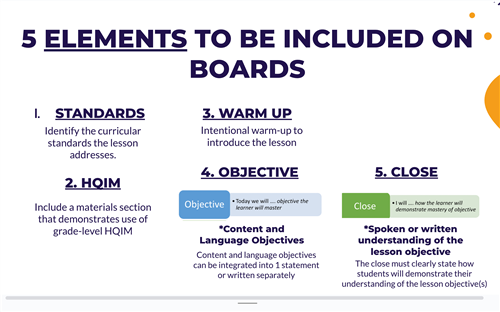- Central High School
- Instructional Expectations
Instructional Expectations and Resources
-
Setting Clear Learning Targets and Framing the Lesson
Building Block 1
- Write target in “Today I/we will...so that I can...” language
- Include language target
Ensure the target includes “so that I can” and “I will know I am successful when...”
Building Block 2
- Add a 3-5-minute quick write as a warm-up
- Use data to inform warm up
Ask students to name the target and how they will learn it and why they are learning it.
Building Block 3
- Students will be able to craft their own targets and reflect on progress.
Steps to Writing Effective Learning Targets
1. Start with the Content Standard or Learning Objective
● Review the content standard or learning objective for the lesson. Identify the key knowledge or skills students need to learn, ensuring alignment with broader curricular goals.
Example: Content standard: "Students will be able to explain the water cycle."
● Language objective: "Students will describe the stages of the water cycle using academic vocabulary."2. Break Down the Standard into Student-Friendly Language
● Convert the technical language of the standard into a simple, student-friendly language.
● Keep sentences clear and age-appropriate.
● Use active verbs that are aligned to the skills (e.g., explain, compare, identify).
Example:Standard: "Explain the water cycle."
● Student-friendly language: "I will learn about the water cycle and explain how water moves between land, air, and water."3. Use the "Today I will...so that I can..." Format
● "Today I will...": Focus on what students will do during the lesson, referring to the key knowledge or skill.
● "So that I can...": Emphasize the purpose of learning, explaining why the skill or knowledge is important.Example:"Today I will learn about the stages of the water cycle so that I can explain how water moves through the Earth."
4. Incorporate Language Objectives (for Multilingual Learners)
● Include language objectives that align with the content target. Consider language functions (e.g., describe, explain, compare) and vocabulary that students will need to use.
● This ensures students engage with the content and develop language proficiency.
Example:"Today I will use words like evaporation, condensation, and precipitation so that I can describe each part of the water cycle."5. Add "I Will Know I Am Successful When..." to Define Success Criteria
● "I will know I am successful when...": Clearly state what students should be able to do to show they have met the learning target. This success criteria provide a clear goal for students and a way for teachers to assess understanding.
Example:"I will know I am successful when I can draw and label a diagram of the water cycle and explain each stage in my own words."6. Make the Purpose and Success Criteria Clear and Meaningful
● Ensure students know why what they’re learning is important and how they can demonstrate their understanding. Connect the skill or knowledge to real-world applications or future learning.
Example: "Today I will solve math problems using fractions so that I can understand how to share things equally. I will know I am successful when I can solve a problem involving sharing pizza slices and explain my solution."7. Check for Alignment and Clarity
● Review the learning target and success criteria to ensure alignment with the standard, clarity for students, and feasibility within the lesson. The target should clearly communicate the what, why, and how of the lesson.
Checklist for Writing Learning Targets
- Is the learning target aligned with the content standard?
- Is the target written in a student-friendly language?
- Does it follow the "Today I will... so that I can... I will know I am successful when..." format?
- Does the target make the purpose of learning clear?
- Are the success criteria clear, measurable, and achievable within the lesson?
- Are the language objectives included, especially for multilingual learners?
- Content Language Domain (Reading, Writing, Speaking, Listening)
- Support: Does the learning target promote student understanding of content and language, as well as provide a way to measure their success?


